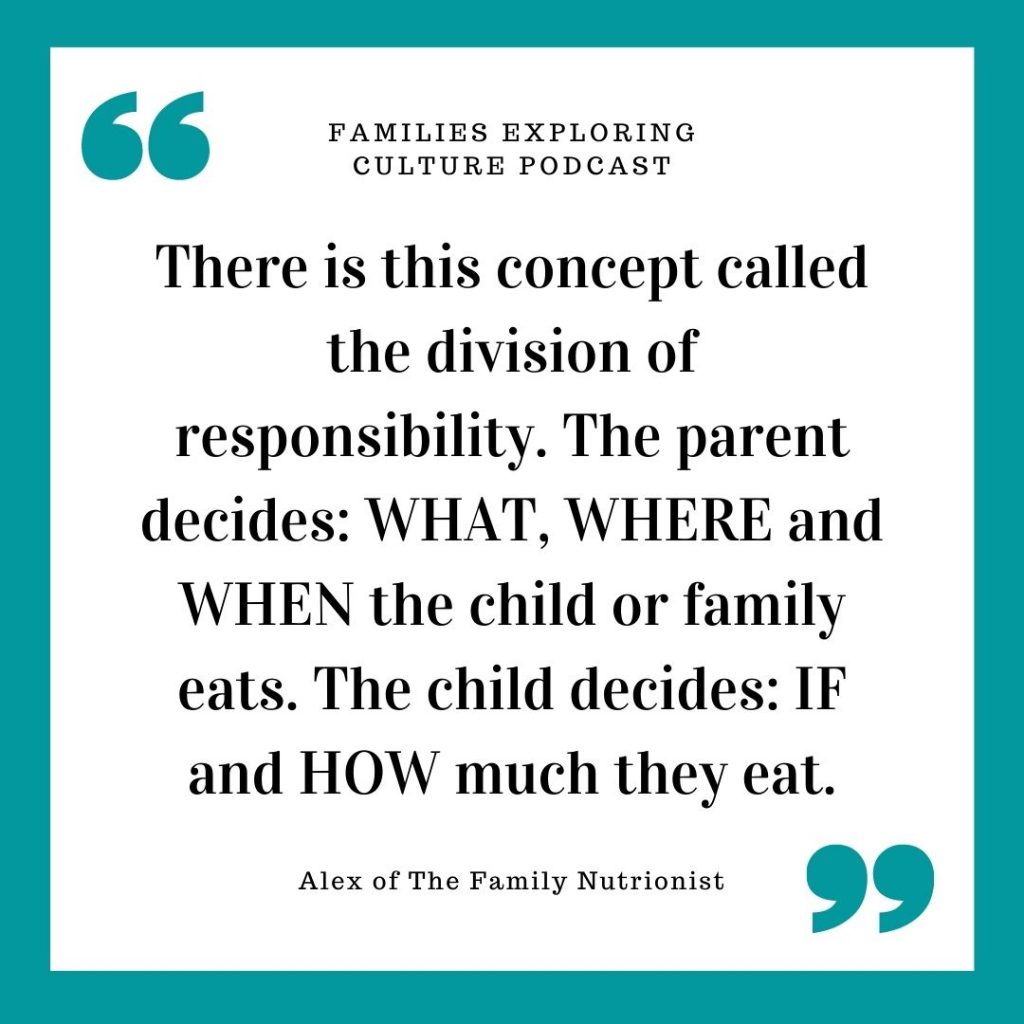06: Strategies to Introduce New Foods To Kids
If you feel overwhelmed just thinking about trying to introduce new foods from around the world to your kids you are NOT alone! Thankfully there are some strategies and changes you can implement to help encourage your picky eater to become a fantastic eater.

As we discussed with Mireille in episode 5, food is a fantastic vehicle for introducing kids to new cultures. But a common problem is how to get kids to actually try these new dishes! In this episode we talk with Alex Turnbull of The Family Dietitian about what strategies we can use to introduce new foods to kids.
In this episode we cover:
- Considerations when introducing new foods from other cultures
- Tips for serving new foods to kids
- How to talk with kids about food
Want more ideas for introducing kids to new foods? See my guide on how to teach your children to become world food explorers for tips and tricks!
Table of contents
Considerations when serving foods from other cultures
There really are no reasons why you shouldn’t serve foods from other cultures to your children. It’s even more important for us to exemplify that willingness to try new foods by trying foods outside of our own comfort zones.
The only considerations that you will want to be mindful of are possible medical reasons to not eat a certain dish like a food allergy or possible choking hazards. Some dishes may be too spicy to start with but you can build up to it.
Serve the same things to everyone
Absolutely! We may all have our tastes and preferences but we should be offering the same thing to the adults and the children.
There is a term called the division of responsibility- as a parent you decide where, when, and what your family eats and your children get to decide if and how much they are going to eat.
You don’t need to be making separate meals for each person at every meal! You can still make it interesting for kids by deconstructing the dish and serving the sandwich ingredients separated out on a plate.

Dealing with picky eaters
Take a step back, remember the division of responsibility, and ask yourself these questions first:
- Are they avoiding certain food groups?
- Do they have an extremely limited amount of foods that they like (20-30 or less)?
If yes to both of these, seek the help of a professional.
One strategy to try is to take the expectation away from eating and move it to interacting. There are a few steps that they go through before actually eating the food:
- Do they tolerate the food?
- Do they interact with the food (smell, touch, taste)?
So start at the beginning of the process of eating food. Here are some strategies to try:
- Start with an itty bitty portion of the food which can make the new food seem more manageable.
- Ask them to play with it, touch it, or lick it. This helps build trust around a food your child doesn’t like.
- If they say they don’t like it, you can say “that’s okay” and ask an engaging question like “can you dip it in the sauce?”
If you can build a positive experience with food even if they don’t eat it, it means the next time they are far more willing to do something with it.
See more ideas for making mealtime fun here.
Other strategies to try
Give them choices between fruit A or fruit B or between two different side dish options. Don’t give them an open ended question because that is too overwhelming either for you or for them.
Be mindful of any outside stressors that can cause picky eating. There are few things that kids have full control over and what foods they are willing to eat is one of those. Sometimes a traumatic event such as a new sibling or moving can cause a regression.
Textures are also a big challenge for many kids particularly in regards to how much effort they have to put into chewing. Ground meats are often more appealing just because of how much easier they are to eat. Try serving the same item prepared in several different ways and with different sauces.
Some strategies to use when plating food
For all kids:
You don’t have to make a Pinterest perfect plate every day but you can vary what you do with their food. If you occasionally put a smiley face on their plate or put their fruit on a kabob stick instead of in a bowl, it can make the eating process more fun and engaging.
Use different utensils like a pick or chopsticks (use a chopstick assist to make it easier) or try serving their food in a muffin tin. It makes it more fun for kids by making one of these small changes.
Portion sizes are a good guide but not the ultimate decision factor when plating. Overall exposure to food is more important. For new foods, it is often better to give them a very small portion to not overwhelm them.
A good rule of thumb for kids, is that a serving size for them is approximately the same size as their palm.
For babies and toddlers:
Don’t overwhelm them with options. Stick to 3-5 foods when plating. Pay attention to sizes and shapes as well as their developmental skill level.
- If they can do the pincher grab, you can do small pea sized shape foods.
- For a palm grab, cut foods into long and thin sticks about the length of your pinky.
- For spoon practice, you can put the food on a spoon for them and let them feed it to themselves from there.
- You can use a mini cookie cutter to cut foods into fun shapes
Changing the way we talk about food
One of the biggest ways that you can de-escalate the mealtime battle is to say “It’s okay if you don’t like it. Can you do cut it with your fork?” instead of saying “You need to eat it!”
Also, don’t place so much emphasis on “good” and “bad” foods but instead discuss what the different kinds of food do for us. A cookie can give our bodies a quick fuel source but it doesn’t last long so we need other foods to fuel it for longer.
It’s also important to place less emphasis on sugar as a reward. Try serving a small treat with the meal which reduces the battle over waiting to earn it.
It’s also important to help talk with your children about the cause and effect of the foods they eat. That way the next time they eat a lot of candy they can recognize that it doesn’t make them feel good. Storybots has a really fun episode on food on Netflix that talks about how our bodies use the food we eat.
The ultimate goal is for our children to be self aware of how food makes them feel. Since we cannot always control outside influences and we aren’t always going to be with them. They need to have a better understanding of the process so that they can be good decision makers.
Other strategies that may help
Stick to structured meal times so that kids are not grazing and filling up on sometimes empty calories.
You can also choose to offer part of the meal as a pre-mealtime snack, ie. place fruit out to snack on instead of waiting for dinner.
This is not an overnight process. It will take time and picky eating habits can run in cycles of better eating and worse eating. Be patient with yourself and your children as you seek to expand their palates and introduce new foods!
Thank you for joining me on this journey! Happy exploring!

Other episodes you may like:
- 05: Connecting Food and Global Learning
- 03: Travel From Home
Listen to this episode
Show notes links
Alex is a mother of both an infant and a toddler – her entire career has been focused on combining her love of food and nutrition for families. Helping others learn how to grow a healthy relationship with food has been her mission over the past several years. She’s worked in weight management, long term care, clinical and foodservice settings. Among all of these, her greatest passion is educating children and families on building healthy, sustainable eating habits.
Pre-motherhood, she obtained her bachelor of science in dietetics from St. Catherine University, where she then went on to obtain her credentials as a Registered Dietitian Nutritionist. She also runs her own blog @TheFamilyNutritionist and works in school foodservice. She is an expert in infant and child nutrition and is passionate about helping parents find ways to feed their families with more confidence and less stress. Personally, Alex loves to eat to live and believes that all foods can fit within a healthy lifestyle. She encourages families to find simple and realistic ways to work towards a healthier and happier life.
You can find some ideas for making mealtime fun for the whole family here.
